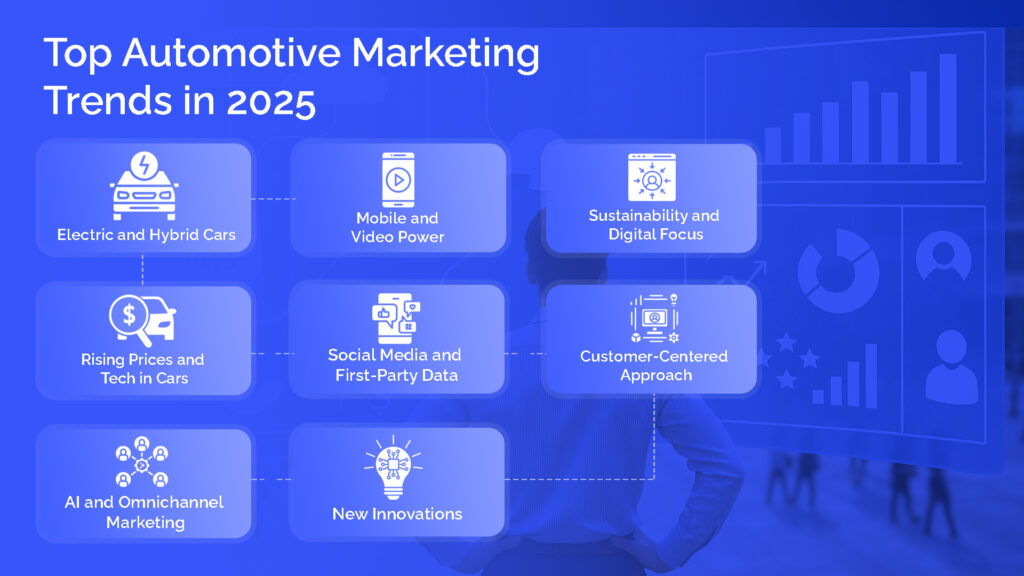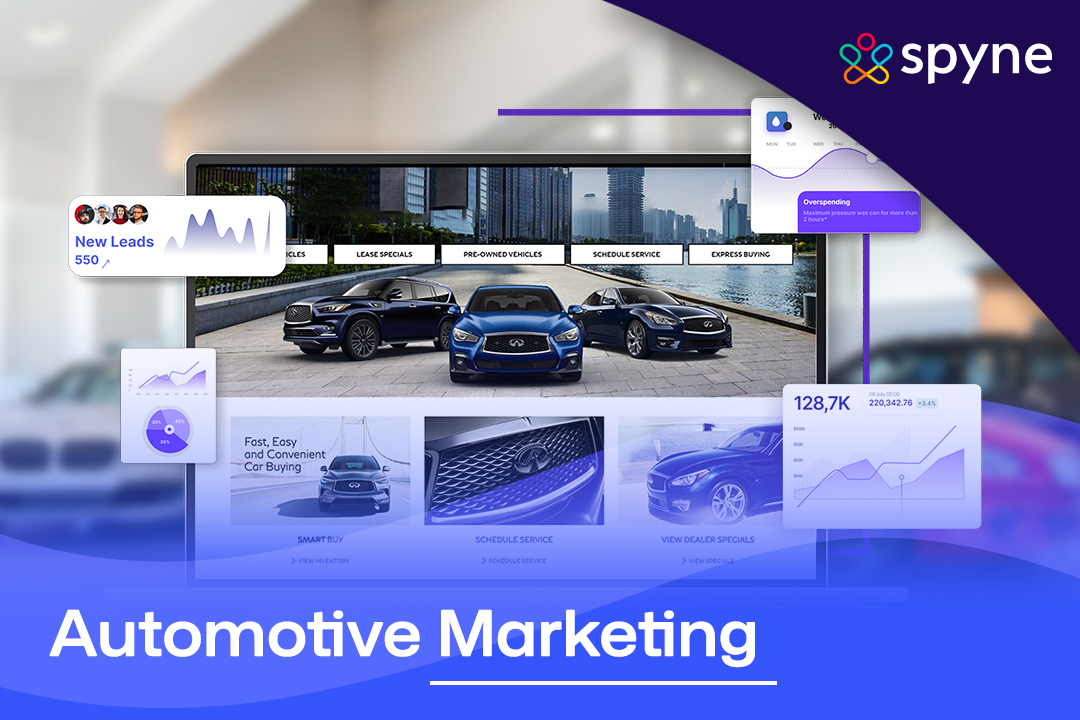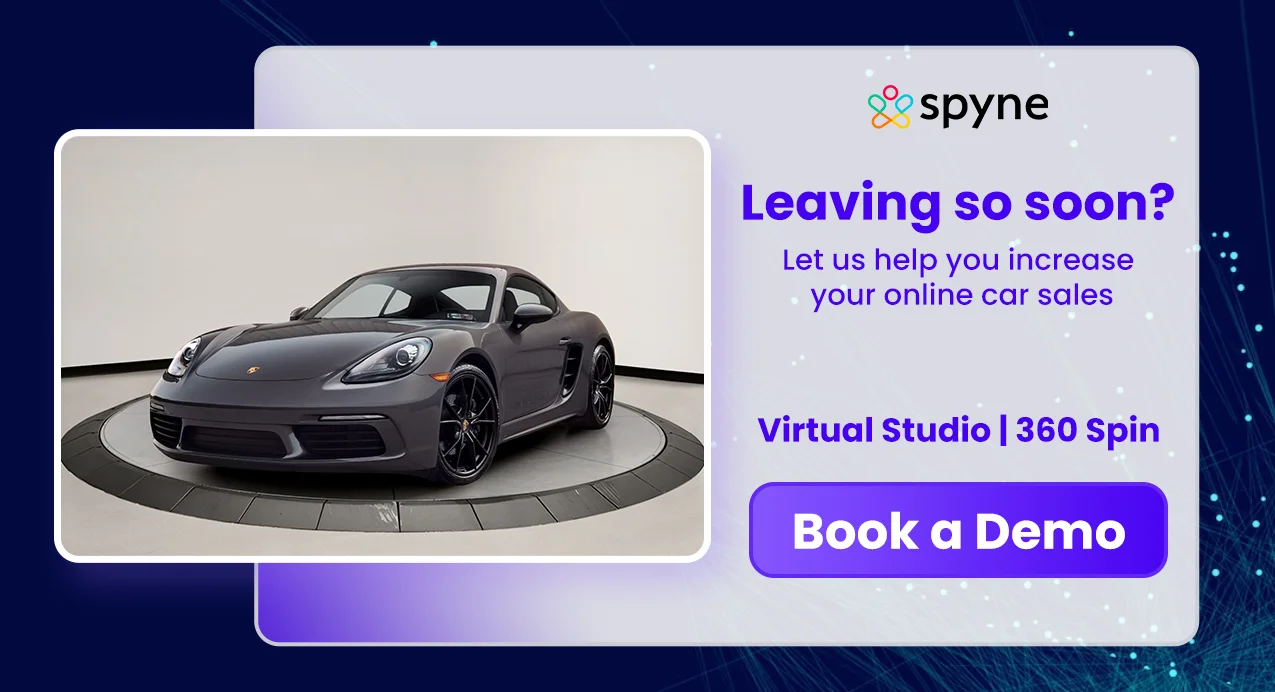Did you know that the automotive industry is one of the largest in the world, consisting of numerous companies covering design, development, manufacturing, marketing, and sales? It also generates massive yearly revenues globally, with countless dealers, brands, and independent sellers jostling for market share. In this cutthroat industry, pooling in new buyers with proper automotive marketing ideas up your sleeve is possible.
As per research, expenditure on digital automotive advertising in the US will surge by 2025, This momentum is set to continue, with digital ad spending in the automotive sector projected to cross $22 billion, paving the way for more intense competition in the global market. Therefore, it’s time to buckle up, chalk out some great digital marketing for car dealership strategies, and seize the deals.
What is Automotive Marketing?
Automotive marketing refers to promoting and advertising vehicles and related products or services within the automotive industry. It involves strategically planning and implementing marketing techniques that attract potential customers and keep them engaged to increase brand awareness, build customer loyalty, and drive sales.
Automotive marketing encompasses a wide range of activities, including traditional advertising, automotive digital retailing, social media campaigns, content creation, events, sponsorships, and other promotional efforts tailored to target specific demographics and meet the needs of consumers interested in automobiles.
The goal of automotive marketing is to position a brand or a particular vehicle as a desirable choice in a competitive market and to establish a strong presence in the minds of potential buyers. Auto marketing helps dealerships connect with potential car buyers, including those who are actively looking to purchase a car and those who are still researching.
Interestingly, only 7-9 percent of car buyers know what they want to buy, while the rest still have an immediate purchase intent. Automotive marketers use effective marketing strategies to capture the attention of these people and drive them to make a purchase.
The Importance of Modern Automotive Marketing in 2025
Automotive marketing is all about promoting your car dealership’s vehicles and related services in the auto industry. It includes everything from old traditional ads to social media campaigns, content creation like blogs and events. The goal is to help car dealerships stand out, connect with buyers, and boost sales.
Marketing helps brands build a strong identity and show what makes them different in the marketplace. For example, a used car dealer can highlight trust and value to attract more buyers. Since only 7-9% of car buyers know what they want to buy, effective marketing can grab the attention of the rest and guide them through the buying journey. It also helps customers understand why they should choose one brand over another.
With modern automotive digital marketing tools, Automotive marketers can reach people on different platforms, keep them engaged, and make them come back. They can also track what customers like, what works in a campaign, and where improvements are needed. In short, automotive marketing isn’t just about selling cars, it’s about building trust, staying connected, and growing smarter with each campaign.
Top 5 Benefits of a Strong Automotive Marketing Strategy
Dealerships actively use strong marketing strategies to reach customers online, build trust, and drive sales by leveraging digital tools and customer reviews.
1. Be Present Everywhere
Most auto buyers spend quite a bit of time online when making a purchase. They flip between websites, applications, and social media to shop for cars and prices. For this reason, your business has to be on all platforms. Having a powerful automotive marketing software strategy serves to reach such buyers and send them in the correct direction.
2. Use the Right Digital Channels
Use platforms such as SEO, Google Ads, emails, and text messages to reach more individuals. These platforms inform you of what is working and how to enhance your automotive product marketing. Keep your website fast, mobile-friendly, and user-friendly, as most individuals begin their car hunt online.
3. Build a Trusted Brand
Marketing also enables you to develop a solid and trusted brand. Demonstrate why your business stands out and excels. Consumers are more apt to select a brand that appears trustworthy and good at communicating.
4. Focus on Customer Experience
Customer focus is extremely valuable. Provide individualized service, useful assistance, and simple steps to buy. This makes consumers happy and committed.
5. Grow with Reviews and Automation
Finally, leverage customer reviews, referral promotions, and marketing automation to expand. Reviews create credibility, referrals get new buyers in, and automation conserves time while keeping leads warm.
An effective marketing strategy keeps you ahead, sells more cars, and constructs long-term success.
Top 3 Real-World Automotive Marketing Examples
Here are some successful real-world car advertising companies campaigns from major automotive brands that showcase their innovative strategies to boost their brand’s visibility and engagement:
1. Mercedes-Benz
Mercedes-Benz partnered with *Avatar: The Way of Water* to promote its new electric vehicles through the “Earth is our Pandora” campaign. Using TV commercials, social media, influencers, and immersive touchpoints, the campaign generated 1 million+ impressions, over 40,000 social engagements, and 100,000 interactions at touchpoints.
2. BMW
BMW Spain launched a TikTok campaign featuring a visually engaging video linked to ads with pre-filled automotive lead generation forms. The campaign enhanced lead quality and lowered CPL by 47% compared to other formats, efficiently syncing data with their CRM to validate potential customers’ email IDs.
3. Toyota
Toyota collaborated with LadBible to target millennials and Gen Z by promoting the NG Yaris as the ultimate post-COVID road trip car. Using a car treadmill simulation, the campaign reached 28.8 million users on social media and increased Yaris’ purchase intent, desirability, and brand consideration.
Top Automotive Marketing Trends in 2025
The auto world is seeing big changes in 2025. A large number of buyers now search for cars online before visiting a dealership. Around 92% begin their journey on the web, but 79% still go to the showroom to make the final purchase. While digital leads are rising, traditional ones are slowing down.
1. Electric and Hybrid Cars
Electric cars are gaining attention and are expected to reach $906.7 billion by 2028 in global market value. But high costs and fewer charging stations make it tough for many. Hybrid cars remain a good pick for those who want lower emissions but aren’t ready for full electric just yet.
2. Rising Prices and Tech in Cars
Car prices have crossed $48,000 on average, pushing many buyers out of the market. At the same time, features like voice control, AI, and entertainment systems are turning cars into smart machines.
3. AI and Omnichannel Marketing
AI tools help marketers reach the right people with better ads. Omnichannel methods let buyers shift between websites, apps, and stores with ease, giving them a smooth experience.
4. Mobile and Video Power
People now use phones more than desktops to explore car options. Over 70% of visits come from mobile. Videos, especially those showing every angle of the car, help buyers choose quickly.

5. Social Media and First-Party Data
Social platforms play a big role in car-buying decisions. With online tracking tools going away, car brands are collecting information directly from buyers to keep their ads effective.
6. New Innovations
Companies are launching virtual showrooms and using tech like AR and VR to improve the shopping journey. Toyota and Kia are already ahead in this game.
7. Sustainability and Digital Focus
Many buyers care about the environment. Car makers are cutting emissions and building greener products. They’re also making websites that are easy to use so buyers can explore cars from home.
8. Customer-Centered Approach
Today’s customers want easy steps, helpful service, and more control. Brands are improving how they sell while keeping dealerships relevant for final decisions.
How to Find Out What an Automotive Customer Wants?
To understand what the auto customer wants, listen to three key areas: target market, buyer behavior, and consumer trends. Here’s how you can do it:
1. Know Your Target Audience
Be specific as to whom your products are targeted. Not everyone is your customer, so specify by segmenting:
- Demographics: Age, gender, where, how much, etc.
- Psychographics: Adventure, luxury, or pragmatism? Do they care about the environment?
- Buyer behavior: Why are they purchasing—business or personal use? How often do they purchase?
Segregate your audience into groups:
- Active customers: Repeat customers who contact you regularly.
- Inactive customers: Customers who have not recently purchased but may return.
- Lost customers: Those who stopped participating but may still be interested.
- Conquest customers: Potential customers who have not yet interacted with your dealership.
2. Understand Buyer Behavior
Understanding the buyer’s behavior process includes:
- Awareness stage: Customers are triggered by a lifestyle shift, vehicle breakdown, or company growth. Connect these triggers with your product solutions.
- Consideration stage: People look online and offline (social media, review sites, friends’ recommendations). Provide them with detailed and descriptive information to allow them to make informed decisions.
- Decision phase: Buyers go to dealerships with careful research. Establish brand awareness early to sway their decision.
3. Stay Up-to-Date with Consumer Trends
Consumers of cars heavily rely on websites: 59% also shop online before visiting dealerships. Smartphone use is up—69% like to scan reviews on cell phones. Social media is important; 71% use it to help with their purchasing process. By focusing on these regions, you are better placed to comprehend customer requirements and create marketing campaigns that resonate with them.
What Automotive Marketing Agencies Do & How to Choose One
If you’re in the auto business, hiring a good marketing agency can really help your dealership grow. These agencies focus on getting more customers, building your brand, and helping you sell more cars, both online and offline.
1. Build a Strong Brand
Agencies help you create a clear image for your dealership so people remember you. They work on your logo, your messaging, and how you come across online and in person.
2. Run Online Ads & Campaigns
They use tools like Google Ads, automotive SEO services, email, and social media to get your dealership in front of the right people. These ads help bring in traffic and turn that into real buyers.
3. Handle Reputation & Ads
A good agency also keeps an eye on your reviews and responds to feedback. They make sure your brand stays trustworthy while planning ads across platforms—TV, social, and even radio.
4. Improve Website & Search Visibility
They build or improve your website so it loads fast, looks great on phones, and shows up on Google when someone searches for a car near them.
5. Create Useful Content & Use Feedback
From blog posts to videos, agencies help you tell your story. They also look at customer feedback to adjust strategies and make your marketing smarter.
How to Pick the Right Agency
Choosing the right marketing agency can transform your automotive business. By setting clear goals, evaluating experience, and ensuring good communication, you can find a partner that boosts your brand and drives results.
1. Set Clear Goals
First, decide what you want to achieve. Do you want more leads, better branding, or higher sales? When you know your goals, you can find an agency that matches them.
2. Choose an Agency with Auto Experience
Pick a team that knows the car industry. If they’ve worked with auto brands or dealers before, they’ll understand your needs better and bring useful ideas to the table.
3. Ask About the Tools They Use
Make sure they use the right tools. They should offer things like ad tracking, email marketing, and customer data tools. These tools help you grow and improve your results.
4. Look at Their Past Work
Check what the agency has done before. Look at their ads, social media posts, or website designs. This shows if their style fits your brand.
5. Pick a Team That Communicates Well
Good communication is very important. Choose a team that listens to you, answers questions clearly, and keeps you updated. This helps things run smoothly.
6. Know the Costs
Ask how much they charge and what’s included. Don’t just pick the cheapest option. Go for an agency that gives you good results for your money.
7. Pick the Right Size Team
A big agency has more people and tools. A small agency gives more personal attention. Choose what works best for your goals and budget.
Top 10 Automotive Marketing Companies in 2025
In 2025’s competitive auto market, these top 10 marketing companies offer specialized services, from AI visuals to omnichannel campaigns, driving automotive success.
| Company Name | Core Services | Distinguishing Feature |
| Spyne | AI-powered visual merchandising, website optimization, SEO, PPC, | AI-enhanced vehicle images, 360° car views, seamless CRM integrations |
| SmartSites | SEO, PPC, web design, email marketing | Google Premier Partner with a strong automotive focus |
| CMB Automotive Marketing | Brand strategy, creative, digital ads | Deep automotive dealership branding expertise |
| Omni Advertising | Full-service media, digital & TV campaign | Specializes in Tier 2 & Tier 3 auto dealer groups |
| The Automotive Advertising Agency | Creative, media planning, video, branding | 100% focused on the automotive industry |
| Dealer World | Direct mail, radio, video, digital ads | In-house media production and custom dealer campaigns |
| Green Line Automotive | Digital retailing, online reputation, SEO | Data-driven marketing with automotive tech integrations |
| Crafted Automotive | Branding, social media, video ads | Boutique creative agency tailored for car dealerships |
| Force Marketing | Omnichannel, CRM, video, fixed ops marketing | Apollo platform for AI-powered automotive campaigns |
| Automotive Marketing Gurus | SEO, video, and creative campaigns | Custom dealership campaigns with an ROI-driven approach |
How Spyne Enhances Your Automotive Marketing
Spyne actively enhances automotive marketing by providing high-quality visuals, optimizing websites, managing leads, optimizing automotive marketing ROI, and integrating seamlessly with other tools. This helps dealerships attract more customers and boost sales.
1. High-Quality Visual Merchandising
- Improved Vehicle Images: Spyne applies AI to enhance car images by stripping backgrounds and applying professional edits. This enhances your car’s appearance online and draws more customers.
- 360° Car Views: Spyne allows you to make 360-degree videos of cars so customers can view them online, as if in a showroom. This increases customer interest and sales.
2. Automotive Website Optimization
- Easy Site Building: Spyne assists you in creating speedy, mobile-supported websites that are simple to browse. The sites are car dealer sites and feature SEO to position them higher in search engines.
- Fast Car Find: Spyne’s AI-powered search tools allow customers to easily find the vehicle they desire right away, enhancing their experience.
- Live Updates: Spyne integrates with your inventory system so your site is always displaying the freshest available cars.
3. Lead Generation and Conversion
- Smart Lead Management: Spyne gauges customer behavior to determine serious buyers, allowing your sales team to prioritize high-value leads.
- Follow-Ups as Per Customer: Spyne monitors customer activity to send targeted messages, increasing the chances of converting leads into sales.
- Chatbots for Instant Responses: Spyne’s AI chatbots respond to customer inquiries in seconds, not letting any lead slip through the cracks.
4. Marketing ROI Optimization
- Make Better Content: Spyne assists in writing car descriptions and social media content to drive more visitors and enhance search rankings.
- Monitor Results: Spyne offers data insights into campaigns and customer actions, enabling you to enhance your marketing efforts.
- Target the Right Customers: Spyne assists you in retargeting potential buyers with ads on platforms such as Google and Facebook.
5. Seamless Integration
- Spyne integrates seamlessly with automotive CRM tools, inventory software, and social networks, so everything can be easily managed together, hassle-free.
- Spyne makes online car dealership marketing easy by enhancing visuals, websites, lead management, and content generation, and working seamlessly with other tools. It assists dealerships in attracting more customers and selling cars quickly.
Conclusion
Strategizing your automotive marketing approach is critical for your automotive digital retailing business. However, it can take a lot of work to keep up with the trends and practices and the infinite transformations in space. These are just a few tips and ideas to help you get a hold of the marketing reins. However, you must evolve and adapt seamlessly to beat the competition.




























